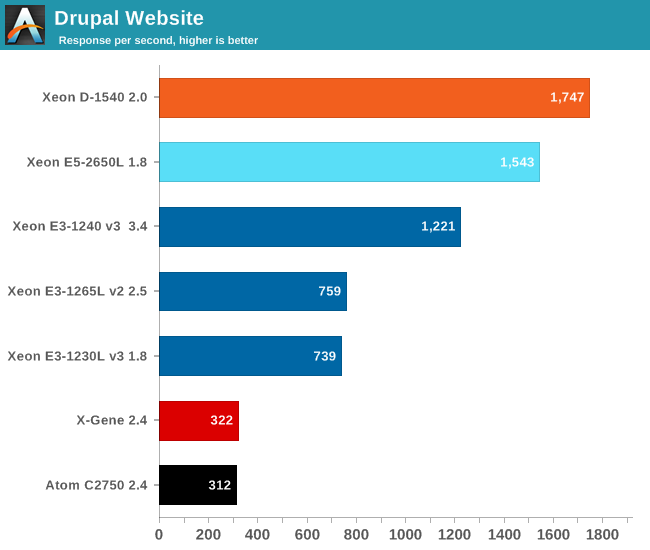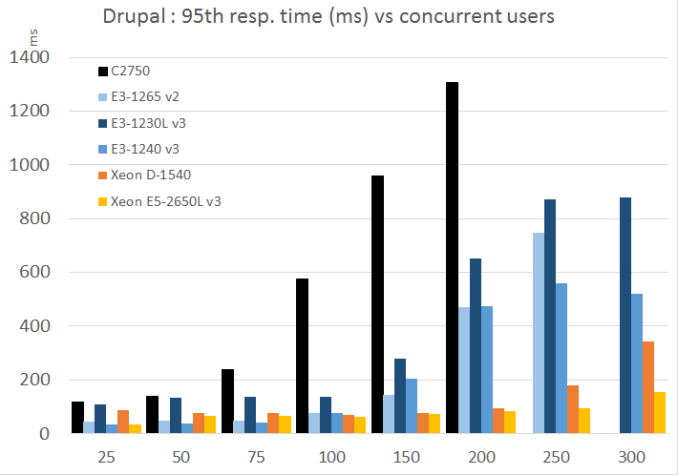The Intel Xeon D Review: Performance Per Watt Server SoC Champion?
by Johan De Gelas on June 23, 2015 8:35 AM EST- Posted in
- CPUs
- Intel
- Xeon-D
- Broadwell-DE
Web Server Performance
Websites based on the LAMP stack - Linux, Apache, MySQL, and PHP - are very popular. Few people write html/PHP code from scratch these days, so we turned to a Drupal 7.21 based site. The web server is Apache 2.4.7 and the database is MySQL 5.5.38 on top of Ubuntu 14.04 LTS.
Drupal powers massive sites (e.g. The Economist and MTV Europe) and has a reputation of being a hardware resource hog. That is a price more and more developers happily pay for lowering the time to market of their work. We tested the Drupal website with our vApus stress testing framework and increased the number of connections from 5 to 300.
We report the maximum throughput achievable with 95% percent of request being handled faster than 1000 ms.

Let us be honest: the graph above is not telling you everything. The truth is that, on the Xeon D and Xeon E5, we ran into several other bottlenecks (OS and Database related) before we ever could measure a 1000 ms 95th percentile response time. So the actual throughput at 1 second response time is higher.
Basically, the performance of the Xeon D and Xeon E5 was too high for our current benchmark setup. Let us zoom in a bit to get a more accurate picture. The picture below shows you the 95th percentile of the response time (Y-axis) versus the amount of concurrent requests/users (X-axis). We did not show the results of the Atom C2750 beyond 200 req/s to keep the graph readable.
We warm up the machine with 5 concurrent requests, but that is not enough for some servers. Notice that the response time of the Xeon D between 50 and 200 requests per second is lower than at 25 request per second. So let us start our analyses at 50 request per second.
The Xeon E3-1230L clock speed fluctuates between 1.8, 2.3 and 2.8 GHz. It is amazing low power chip, but you pay a price: the 95th percentile never goes below 100 ms. The highly clocked Xeon E3s like the 1240 keeps the response time below 100 ms unless your website is hit more than 100 times per second.
The Xeon D once again delivers astonishing performance. Unless the load is more than 200 concurrent requests per second, the server responds within 100 ms. There is more. Imagine that you want to keep your 95th percentile. response time below half a second. With a previous generation Xeon E3, even the 80W chip will hit that limit at around 200-250 requests per second. The Xeon D sustains about 800 (!) requests per second (not shown on graph) before a small percentage of the users will experience that response time. In other words, you can sustain up to 4 times as manyhits with the Xeon D-1540 compared to the E3.











90 Comments
View All Comments
julianb - Saturday, October 31, 2015 - link
Thanks for the reply, man.And sorry for my late reply, totally forgot about this thread :)
eva2000 - Tuesday, June 23, 2015 - link
Nice... Xeon D-1540 is awesome, but I wish it was clocked 0.2Ghz higher across the board would be just enough to tip that scale versus E5. Did my own benchmarks at https://community.centminmod.com/threads/2864/ :)extide - Wednesday, June 24, 2015 - link
Thats probably exactly why it ISNT clocked 0.2Ghz higher across the board ;)I'm sure Intel wants to see some space between this and E5.
boogerlad - Tuesday, June 23, 2015 - link
If this was marketed for the consumer market with the ability to overclock, this would outsell everything completely. This is what the enthusiast needs!!!Refuge - Tuesday, June 23, 2015 - link
I don't think this is going to do much of anything for an enthusiast.Unless they are interested in building a server for some experiment or project.
JohanAnandtech - Wednesday, June 24, 2015 - link
I still think the i7 59xx series is a better match for consumers: higher clocks and thus ST performance. The Xeon D most interesting features such as integrated 10 GBe and low power don't interest most performance consumers. Most people will have a hard time saturating a 1 GBe line and power savings are not a priority.tspacie - Wednesday, June 24, 2015 - link
Seems to tick all the boxes for a software development machine. Very good at compilation. Reasonably priced for the performance. Low power. ECC memory. I'm temptedextide - Wednesday, June 24, 2015 - link
EXACTLY what I was thinking!MrSpadge - Saturday, June 27, 2015 - link
I would be very tempted by such a chip as well, using it for BOINC. However, Broadwell looses some of the power efficiency advantage if you push it harder, i.e. the largest gains are at low and moderate frequency. Perfect for such server chips and mobile ones, but not so much for people aiming for 4+ GHz.MaxKreimerman - Tuesday, June 23, 2015 - link
Sounds impresive in just 45w package, but imposible to find in the retail sites such as newegg or wiredzone